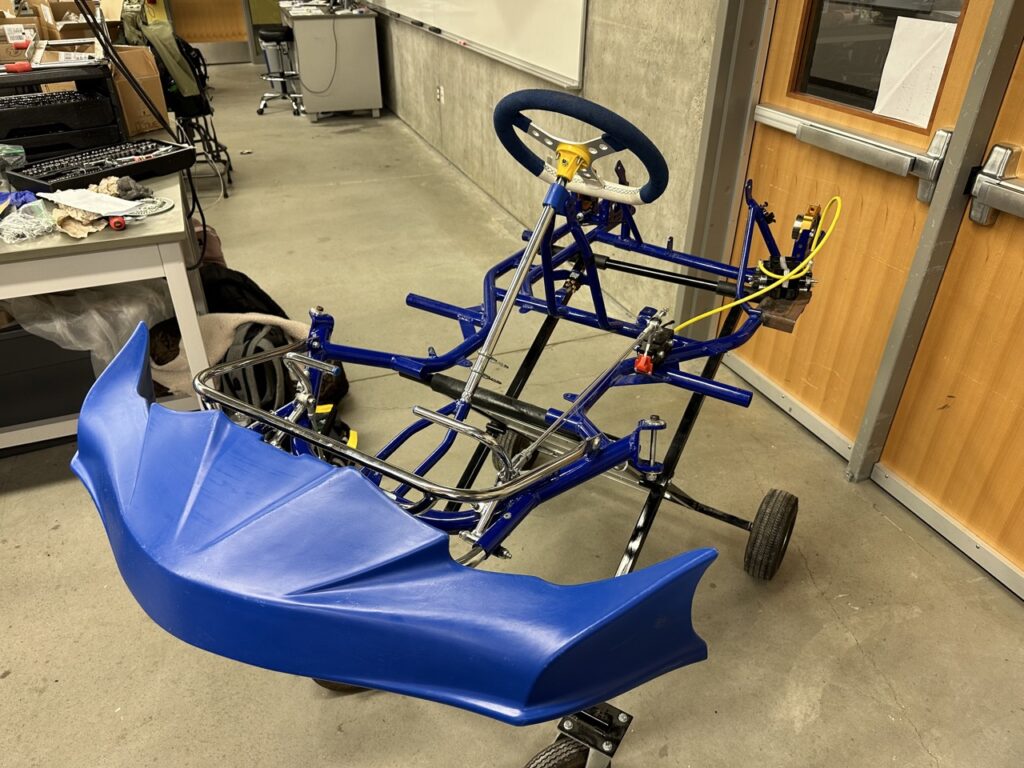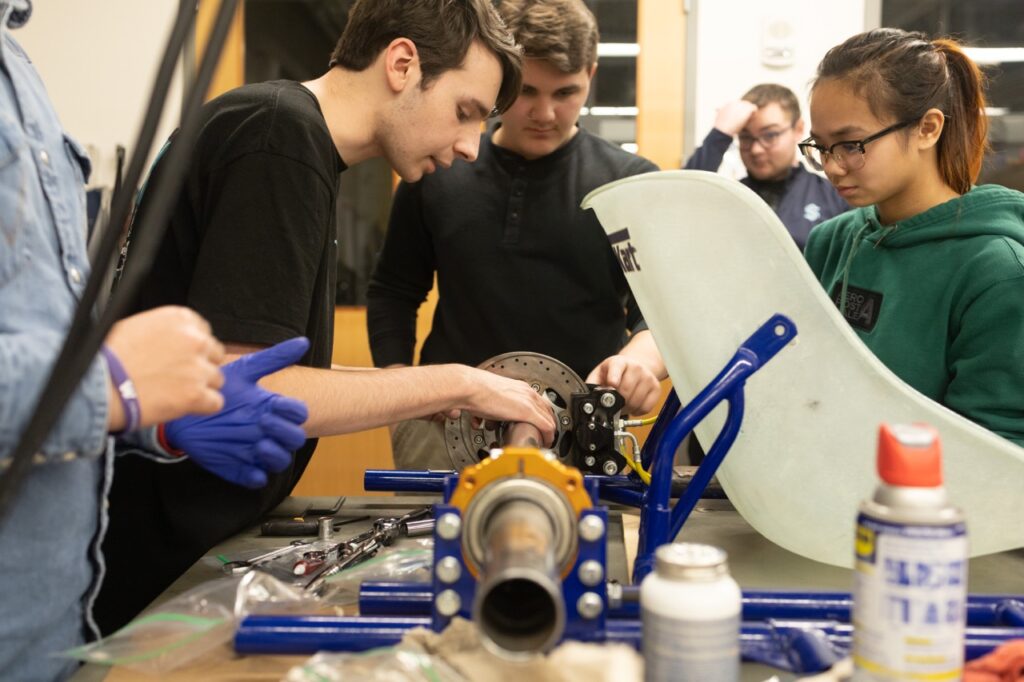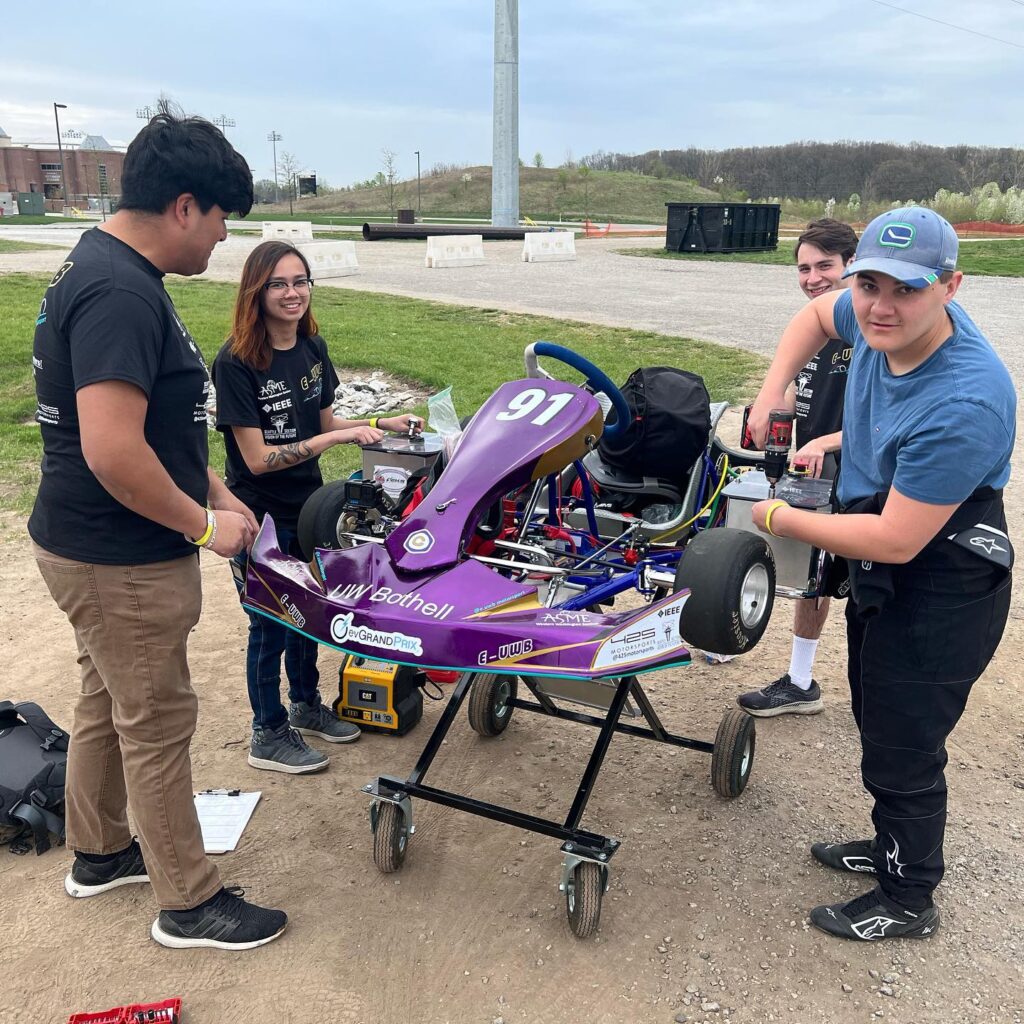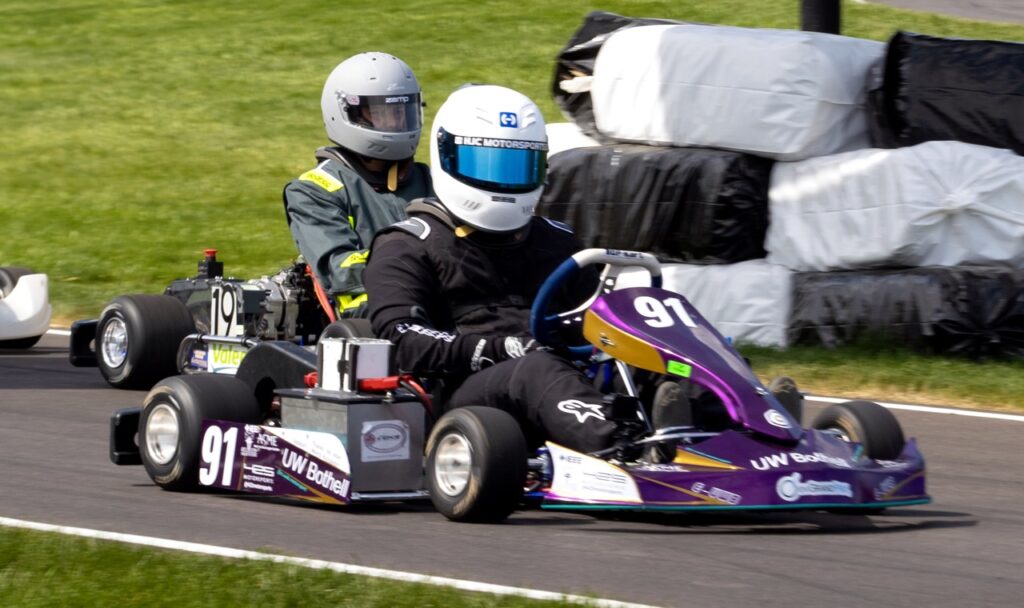This is a story of perseverance and grit. A story that began in September 2022 when student engineers Jordan Belknap, Samantha Brown, Giuliano Bussadori and Adrian Corona came together, bound by a dream of competing in the EV Grand Prix — a competitive, electric go-kart race hosted for collegiate teams by Purdue University.
Much more than just a few laps around a track, participants often spend a full year preparing for this competition as they are required to develop a design report and build their own karts. This includes assembling the chassis and integrating a powerful electric motor and large battery pack, all while maximizing energy efficiency.
It is only after all of this is complete that students get to finally rev their engines and take off on the track.
“This was a real passion project for all of us,” said Belknap, a senior majoring in Mechanical Engineering and team principal. “There were so many instances where we could have just given up, but we didn’t. We saw it through to the very end, and I’m proud of that.”
On your mark
The students, all in the School of STEM, were part of UW Bothell’s Electric Motorsport Club, which was founded by Belknap in autumn quarter 2022. Unfortunately, the timing was after the deadline to receive funds from the Services & Activities Fee and the Student Technology Fee committees. Consequently, they were not eligible to receive financial support from the University to compete in this year’s race.
Where there is a will, however, there is almost certainly a way — and these students found it. Despite not having any prior fundraising experience, they reached out to various individuals and companies such as the Western Washington American Society of Mechanical Engineers and the Institute of Electrical and Electronic Engineers. All told, they were able to secure nearly $7,000.
They even gained a third sponsor, 425 Motorsports, after Belknap stopped by the store on a Saturday afternoon and shared their aspirations with upper management. “None of us had any sales experience going into it. We kind of just learned through trial by fire, sending out emails and making phone calls,” he said. “But hey, it worked.”
The students themselves contributed more than $1,500 and purchased a kart chassis from the University of Wisconsin. Buying it secondhand saved them money, but it did cost them time, something they could less afford. It arrived only one month before the race, giving them only one-twelfth the amount time to prepare as their competitors who, likely, had been working on their chassis builds for close to a year.

“It arrived on a Thursday night, and we were all hands on deck,” said Bussadori, a senior majoring in Computer Engineering and the team driver. “We had all our club members help us unload the crate and bring it inside the capstone lab. We even had students from other engineering disciplines come and help, too.”
The students stayed late into the night and returned first thing the next day. “We spent the entire day putting the kart together — the front and rear hubs, the entire rear axle and all of the mechanical components,” Belknap said. “By the end of that Friday, we did probably two weeks of work in two days, and that really helped us a lot.”
Get set
The most important part of the kart assembly is the battery and motor.
“When racing electric go karts, several energy transfers occur,” Bussadori explained. “Chemical energy from the battery pack is converted into electrical energy that is then passed to the motor through various controllers. The motor converts the electrical energy into rotational force, which spans the rear axle and tires through the chain. The more efficient energy can be transferred to spinning the rear axle, the faster the kart can go.”
The choice of motor and battery, then, is extremely important. The team decided on the magnet brushed DC motor as it was included in their purchase, making it cost effective and convenient, although not as functional as they would have preferred. “This motor lacked efficiency, but it enabled our team to focus our remaining funds on purchasing batteries, missing components and safety equipment,” said Bussadori.

The original plan was to use lithium-ion batteries but unfortunately they did not arrive in time. “We waited and waited until we seriously couldn’t wait any longer,” said Corona, a senior majoring in Mechanical Engineering and the team photographer. “We really wanted to use these specific batteries because they would increase the kart’s speed and longevity. But when they still hadn’t arrived months after ordering and the competition was then two weeks away, we knew we had to pivot. Our focus was solely on how we could meet our goal and compete.”
The answer: automotive lead-acid batteries. “These batteries gave us one-sixth of the energy and three times the weight,” Corona said. “They were far from giving us the performance and didn’t really help us much at all, other than they were available at nearby stores and would at least get us to the competition.”
And that became their main objective. “We had already paid for the series registration, and we wanted to go, even just to gain experience for ourselves as a team and to show our end product,” said Brown, a junior majoring in Mechanical Engineering and the mechanical driver team lead. “We felt that even if we didn’t place well, at least we achieved what we set out to do. So that’s what we transitioned to expectation-wise.”
Go!
On April 13, the team boarded a plane and set off on their collective dream of competing in the EV Grand Prix. The event was broken into three parts: the design report analysis, qualifying evaluation and the team efficiency competition. Despite all the setbacks the students faced, they placed second out of 16 in the design report as well as in the qualifying evaluation.
“In our report, we included a lot of details and reasoning to explain what we would have designed had the batteries arrived,” Belknap said. “We expressed that even though we didn’t have them, we wanted to still compete for future sponsorship, to build our team and to gain more experience — and it turns out that the judges really liked our initiative.”

The score on the design report dictates where a team’s kart starts in the qualifying race. With 16 total competitors, there are two separate races with eight cars per race. The team that placed first in the design report started first in the first race; the UW Bothell team placed second, so they started first in the second race. “We were not expecting that at all,” Belknap said, “so that was pure elation for us.”
Bussadori drove the car, and the team watched with bated breath as it passed not one, not two, but three cars and slid into first place. Their car led the race for 14 of the 15 laps before it was passed and, ultimately, finished second. “Lead-acid batteries are very comparable to the lithium ions for about the first 15% to 20% of the battery life. But then that last 30% to 40% of usable battery percentage just drops off exponentially, which is when we got passed,” Bussadori explained. “We are still really proud, though.
“We had so many people come up to as afterward in shock that we did so well with the batteries we had.”
“We expressed that even though we didn’t have them (lithium-ion batteries), we wanted to still compete for future sponsorship, to build our team and to gain more experience — and it turns out that the judges really liked our initiative.”
Jordan Belknap
Victory lap
From their high scores in the report and qualifying race, the students started fourth overall in the final competition. “I remember vividly just seeing our cart being placed up so high,” Brown said. “It was very surreal, and I just couldn’t believe we made it that far.”
The team proudly placed 10th out of 16 in that final race. “For me, I’m most proud of the fact that we’ve done something that I don’t think any other club has done so far, at least not in this timeframe, to this extent and to a competition of this level,” Belknap said. “We managed to go from nothing to having a competitive cart within three months — of which only about four weeks were actually usable for us to make a difference.”

Adding to this, Bussadori said, “I feel like there were a lot of times we could have said, ‘You know what? Things aren’t looking good. We can’t do this event.’ But [despite] everything that came up, we decided to just persevere.”
Looking to the future, the team is excited to display their go-kart at club fairs and at events with different industry partners.
“Our team has made great professional connections and experience, and we look forward to continuing to provide students with excellent hands-on experience for the coming years,” Belknap said, “and certainly, to larger EV design competitions in the future.”




